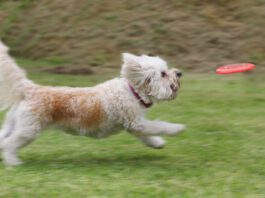Using Enrichment to Meet Your Dog’s Needs: A Fun and Humane Tool For Solving...
Enrichment not only improves the quality of your dog's life, but is a fun and humane tool that can solve a dog's behavioral issues for your benefit.
Happy Tail Syndrome
This common dog tail injury occurs when dogs wag their tails and repeatedly hit things with it.
How to Stop Your Dog From Begging for Your Food
To stop your dog’s begging, first make sure no one is reinforcing the behavior. Then you can teach her a new mealtime routine.
Why Dogs Chase Their Tails
Some dogs chase their tails when they are excited and some puppies bite their tails in play or frustration. Watching your dog chasing his tail is funny, but should you be worried?
Why Do Dogs Dig In Their Beds?
Dogs dig in their beds for many reasons, but behaviorists say the No. 1 reason dogs dig in their beds is instinct. It’s what Mother Nature tells them to do before they lie down.
Why Do Dogs Like Squeaky Toys?
Dogs like squeaky toys because they awaken their predatory behavior, play drive, and love of interaction.
Does Spaying or Neutering Change Dog Behavior?
Why “fixing” your dog may not fix the behaviors that you find problematic.
Why Does My Dog Stare at Me?
Your dog may stare at you for many reasons. A dog may stare to get your attention, to communicate with you, or she may use a creepy stare to warn you to “back off.” To understand why your dog stares, read her body language.
Excessive Panting in Dogs
Dogs pant for several reasons, the main one being to cool themselves. Dogs can’t perspire the way humans do, though they do have sweat...
Can Dogs Eat Mango?
The mango packs a juicy punch when you’re trying to “treat” your dog right. So yes, dogs can eat mangoes if you prepare them properly.
Why Do Dogs Tilt Their Heads?
To hear better, see better and to communicate are just a few reasons why your dog tilts his head at you.
For Better Dog-Behavior Training: Pretend Your Dog Is a Tiger
Owners often turn to dog trainers when they’re feeling exasperated. They report that their dog has the following behavior and training issues:
Has no...


















